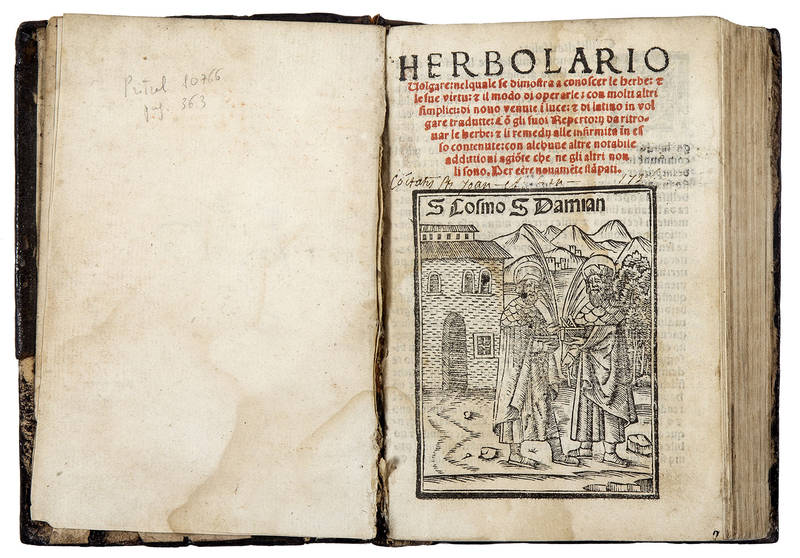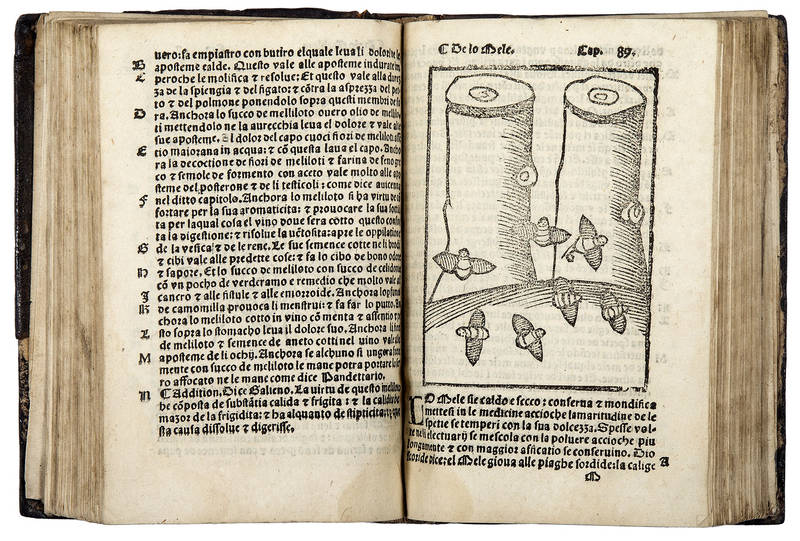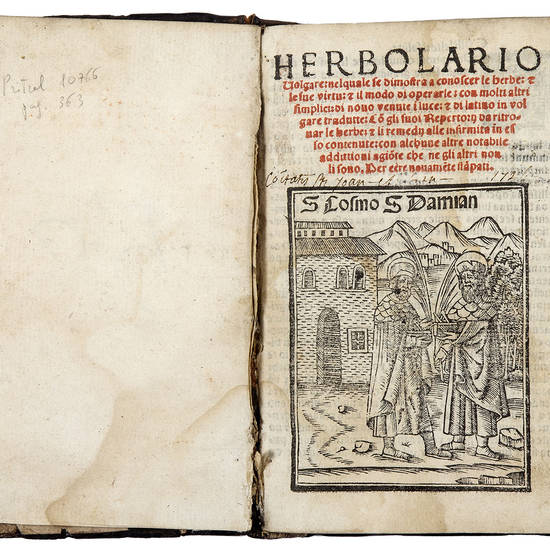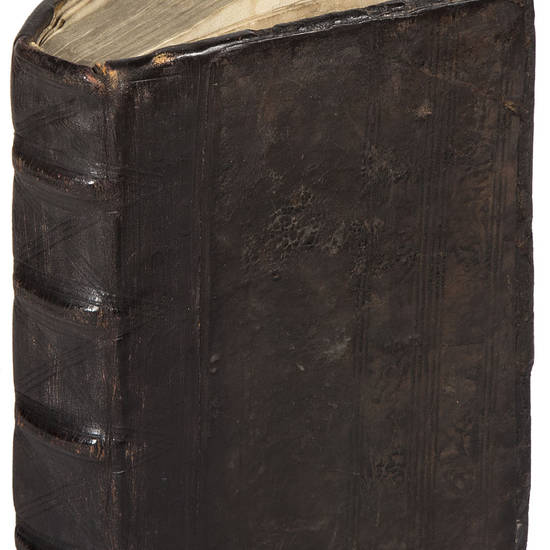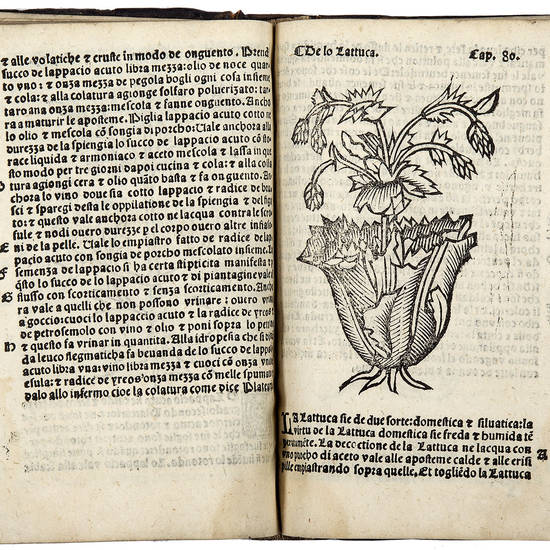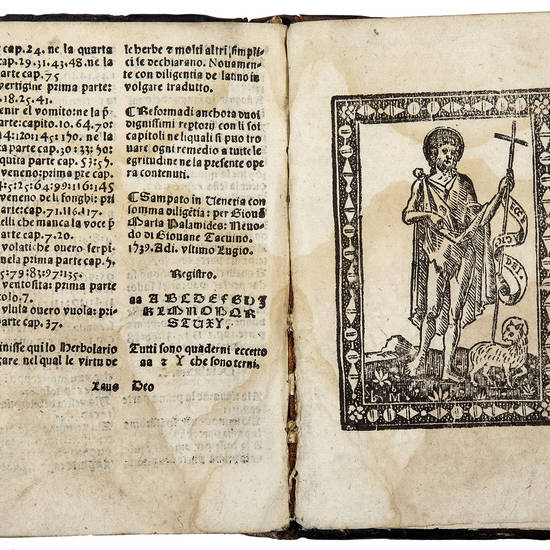Herbolario volgare: nel quale se dimostra conoscer le herbe: et le sue vrtu: et il modo di operarle: con molti altri simplici: di novo venute in luce: et di latino in volgare tradutte: con gli suoi repertorii da ritrovar le herbe: et li rimedij alle infirmita in esso contenute:…
Autore: HERBOLARIO VOLGARE
Tipografo: Giovanni Maria Palamides
Dati tipografici: Venezia, 1539
8vo (154x101 mm). [6], 152, [22] leaves. Collation: AA6, A-X8, Y6. Title page printed in red and black with a large woodcut vignette showing Saints Cosma and Damian. With 151 woodcut illustrations, all depicting plants apart from two which present sacred images (ll. AA6v and last leaf recto). Contemporary blind-tooled calf, spine with four raised bands (rebacked, panels heavily restored, original endleaves preserved). 18th-century erased ownership entry on title page. Small wormhole to inner margin of a few leaves without loss of text, some light marginal damp stains, all in all a very good genuine copy.
RARE EARLY EDITION of this popular work printed for the first time by Bindoni in Venice in 1522.
All early printed herbals (Italian, Dutch, French, English, and German) basically derive from the Herbarium Apulei Platonici (Rome, ca. 1481, erroneously attributed to Apuleius but actually written between the 4th and 5th century AD) and from the Herbarius Maguntinus (Mainz, Peter Schöffer, 1484); both editions are based on an older manuscript tradition which had combined ancient and medieval knowledge of plants. In Germany, the text became popular under the title Hortus Sanitatis, translated as Gart der Gesundheit. In Italy, the text of the Mainz edition was reprinted in Vicenza in 1491 under the title Tractatus de virtutibus herbarum with a new series of more naturalistic woodcuts and with an incorrect attribution to Arnaldus of Villanova. The Herbolario volgare derives text and pictures, with few variations, from the Vicenza Latin incunable.
The present is the fifth edition in Italian, basically a reprint of the 1534 G.A. Vavassore edition. Between them is a 1536 edition issued by A. Bindone & M. Pasini that contains 170 illustrations. “All the woodcuts belong to the Latin Hortus Sanitatis, but are not printed from the blocks used in the 1534 edition. The cut of the annunciation occurs first in a devotional book of 1524 […] The woodcuts 109, 143 and 149 are slightly different from the corresponding ones in the 1534 edition; the woodcuts 2-3 are exchanged by misprint” (Klebs, pp. 9-10).
Latin and vernacular herbals were so successful because their simple alphabetical arrangements allowed herbalists, apothecaries, and physicians to easily access essential concepts of pharmacopoeia that earlier medieval authors had drawn from antiquity. From a scientific point of view, however, they are of little value, as their often-imprecise descriptions do not allow for the identification of plants, and therapeutic uses are frequently associated with magical-astrological practices.
A. Arber, Herbals, their Origin and Evolution. A Chapter in the History of Botany, 1470-1670, Cambridge, 1912, pp. 11-13; C. Klebs, A Catalogue of early Herbals, Lugano, 1925, no. 18; G.A. Pritzel, Thesaurus literaturae botanicae, Milano, 1950, no. 10766; C. Nissen, Die botanische Buchillustration, Stuttgart, 1966, no. 2318. Prince d'Essling, Les livres à figures vénitiens, 1st part, II, Florence-Paris, 1908, pp. 462-463, no. 1196.
[6943]

